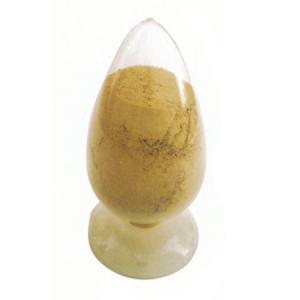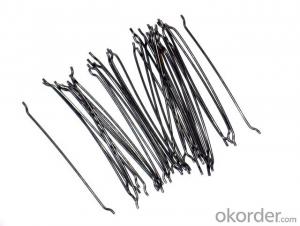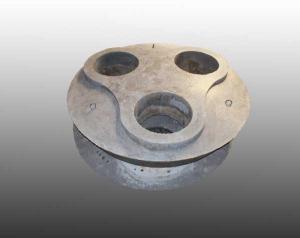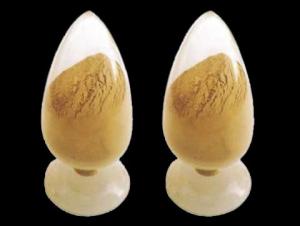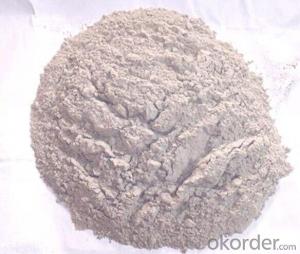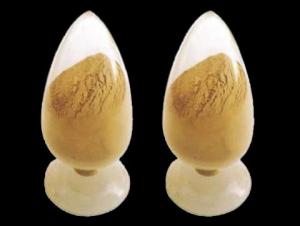Painting Material for Tundish
- Loading Port:
- China Main Port
- Payment Terms:
- TT or L/C
- Min Order Qty:
- 2 Mt m.t.
- Supply Capability:
- 5000 Tons Per Month m.t./month
OKorder Service Pledge
OKorder Financial Service
You Might Also Like
General Information of Painting Material for Tundish
Made as per international standards, ALRE painting material for tundish is known for its excellent corrosion resistance, long operating life and high refractoriness. Further, these can be provided in different specifications as required by the clients.
Technical data of Painting Material for Tundish
Item | Painting material for tundish | ||||
Al2O3 | % | ≥ | — | ||
MgO | % | ≥ | 60-85 | ||
CaO | % | ≤ | — | ||
SiO2 | % | ≤ | — | ||
SiO2+ Fe2O3+ Al2O3 | % | ≤ | |||
Bulk density ≥ | g/cm3 | 2.0 | |||
C.C.S. (MPa) ≥ | 110℃×24hrs | 5.0 | |||
1500℃×3hrs | 8.0 | ||||
M.O.R.(MPa) ≥ | 110℃×24hrs | — | |||
1500℃×3hrs | — | ||||
Refractoriness (℃) ≥ | — | ||||
Grain size (mm) ≤ | 3 | ||||
Permanent linear change | 1500℃×2hrs | — | |||
1500℃×3hrs | -2.5~-1.0 | ||||
Life time (hr) | 10-40 | ||||
Production line and Packing of Painting Material for Tundish
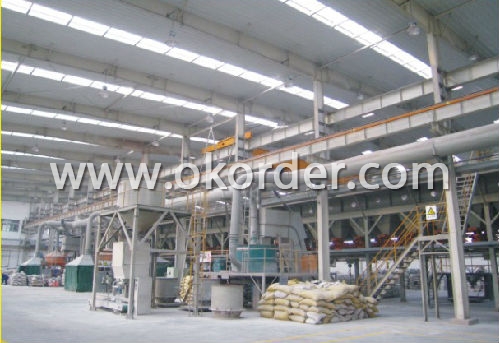

Feature of Painting Material for Tundish
Easy execution and mending
Excellent abrasive resistance performance
Excellent corrosion and scouring resistance of iron steel
Application of Painting Material for Tundish
ALRE painting material for tundish could be used widely for ladel and tundish of stell and iron industry.
- Q:How do monolithic refractories improve the efficiency of ladle and tundish drying furnaces?
- Monolithic refractories improve the efficiency of ladle and tundish drying furnaces in several ways. Firstly, monolithic refractories offer a high degree of thermal insulation. These refractories have low thermal conductivity, which means they can effectively reduce heat transfer from the furnace to the surrounding environment. This insulation property helps to minimize heat losses, allowing the furnace to maintain a higher temperature for a longer period of time. As a result, the drying process becomes more efficient as the heat is retained within the furnace, reducing the overall energy consumption. Secondly, monolithic refractories have excellent resistance to thermal shock. During the heating and cooling cycles of the furnace, rapid temperature changes can cause stress and cracks in the refractory material. However, monolithic refractories are designed to withstand these thermal shocks and maintain their structural integrity. This durability ensures a longer lifespan of the refractory lining, reducing the need for frequent repairs or replacements. Consequently, the furnace operates at optimal efficiency without the downtime associated with maintenance. Additionally, monolithic refractories provide good mechanical strength and abrasion resistance. These properties are crucial in ladle and tundish drying furnaces, as they are exposed to mechanical stresses and abrasive materials such as molten metal and slag. The use of monolithic refractories ensures that the lining can withstand these harsh conditions without undergoing structural damage. This resistance to wear and tear increases the overall efficiency of the furnace, as it can operate for longer periods without interruptions. Lastly, monolithic refractories offer greater design flexibility compared to traditional brick or tile refractories. Their ability to be cast or gunned onto the lining surface allows for easy installation and repair. This flexibility enables the furnace to be customized and adapted to specific requirements, ensuring optimal heat distribution and efficient drying processes. In conclusion, monolithic refractories improve the efficiency of ladle and tundish drying furnaces through their thermal insulation, resistance to thermal shock, mechanical strength, and design flexibility. By reducing heat losses, increasing durability, withstanding harsh conditions, and allowing for easy installation and repair, these refractories optimize the performance and energy efficiency of the furnaces.
- Q:What are the typical applications of monolithic refractories in the iron and steel industry?
- Various applications within the iron and steel industry widely utilize monolithic refractories. These refractories, composed of a single material, offer numerous advantages including easy installation, thermal shock resistance, and excellent resistance to chemical attacks. Below are some typical applications of monolithic refractories in the iron and steel industry: 1. Blast Furnace: In blast furnaces, monolithic refractories line the interior and endure extreme temperatures and chemical reactions. They provide thermal insulation, prevent erosion, and resist the corrosive effects of molten iron and slag. 2. Ladles and Tundishes: Monolithic refractories line ladles and tundishes, vessels used for transporting and transferring molten metal. These refractories offer effective thermal insulation and resistance to erosion and chemical attacks, ensuring the integrity of the vessels. 3. Steelmaking Converters: Converters, essential in the steelmaking process to convert molten pig iron into steel, utilize monolithic refractories. These refractories provide protection against high temperatures and aggressive chemical environments encountered during the process. 4. Electric Arc Furnaces (EAF): Monolithic refractories line the walls and roofs of EAFs, used to recycle scrap steel by melting it. These refractories offer outstanding thermal insulation, resistance to slag erosion, and thermal shock resistance, ensuring the longevity and efficiency of the furnace. 5. Continuous Casting: Monolithic refractories find employment in the continuous casting process, where molten steel solidifies into a continuous slab or billet. These refractories line the walls and floors of the casting molds, providing thermal insulation and resistance to chemical attacks from the molten steel. 6. Reheating Furnaces: Monolithic refractories are used in reheating furnaces, which heat steel billets or ingots prior to further processing. These refractories provide insulation, high-temperature resistance, and ensure uniform heating of the metal. Overall, monolithic refractories play a crucial role in the iron and steel industry by providing reliable and durable linings in various applications. Their ability to withstand extreme temperatures, chemical attacks, and thermal shocks makes them indispensable for maintaining the integrity and efficiency of the production processes.
- Q:What are the environmental considerations associated with monolithic refractories?
- The environmental considerations associated with monolithic refractories primarily revolve around their production and disposal. The manufacturing process of monolithic refractories involves high energy consumption and emissions, contributing to carbon dioxide and other greenhouse gas emissions. Additionally, some raw materials used in their production, such as silica, can have negative environmental impacts during extraction. In terms of disposal, monolithic refractories are typically difficult to recycle due to their composition and structure. As a result, they often end up in landfills, which can contribute to pollution and waste management issues. Overall, the environmental considerations associated with monolithic refractories highlight the need for sustainable manufacturing practices, improved waste management strategies, and the development of alternative refractory materials that have less negative environmental impact.
- Q:What are the challenges in recycling monolithic refractories?
- One of the main challenges in recycling monolithic refractories is their composition. Monolithic refractories are typically made from a combination of different minerals, binders, and additives, which can make the separation and recovery of individual components difficult. Additionally, the high temperatures at which monolithic refractories are used can cause chemical reactions and physical changes that affect their recyclability. Furthermore, the presence of contaminants, such as metal oxides or impurities from the manufacturing process, can also pose challenges in the recycling process. Overall, developing efficient and cost-effective recycling methods for monolithic refractories requires addressing these challenges and finding innovative solutions.
- Q:How do monolithic refractories perform in high-temperature environments?
- Due to their unique characteristics, monolithic refractories are highly effective in high-temperature environments. Unlike traditional refractories made of multiple bricks or tiles, these refractories are composed of a single, continuous composition. This monolithic structure offers several advantages when it comes to performance in high-temperature conditions. First and foremost, monolithic refractories exhibit excellent thermal shock resistance. They can endure rapid temperature changes without cracking or spalling. While high temperatures can impose significant stress on materials, the monolithic structure allows for better expansion and contraction, minimizing the risk of damage. Furthermore, monolithic refractories possess high resistance to chemical attack. In high-temperature environments, aggressive chemical agents are often present, which can corrode and erode traditional refractory materials. However, the monolithic composition is typically designed to be chemically inert, creating a protective barrier against these corrosive elements. Moreover, monolithic refractories offer superior strength and durability at high temperatures. Their single composition ensures a dense and compact structure, reducing the likelihood of cracking or breaking under extreme thermal conditions. This strength enables them to maintain their integrity and performance even in the most demanding environments. Additionally, monolithic refractories can be easily installed and repaired. Unlike traditional refractories that demand precise brick or tile placement, monolithic materials can be poured or sprayed into place, adapting to any shape or size. This flexibility expedites installation, making it more cost-effective and reducing downtime and maintenance costs. Overall, monolithic refractories excel in high-temperature environments due to their thermal shock resistance, chemical inertness, durability, and ease of installation. Their capacity to withstand extreme heat and harsh conditions makes them the preferred choice for industries such as steel, cement, glass, and petrochemicals, where high temperatures are prevalent.
- Q:How do monolithic refractories enhance the performance and longevity of furnaces?
- Monolithic refractories enhance the performance and longevity of furnaces by providing superior thermal insulation properties, excellent resistance to thermal shocks, and high mechanical strength. They create a seamless lining, eliminating joints and weak points, which reduces heat loss and prevents the penetration of molten metals or aggressive chemicals. Moreover, monolithic refractories offer flexibility in design and installation, allowing for customized shapes and sizes to maximize the efficiency of the furnace. Overall, their use enhances the overall heat transfer, reduces energy consumption, and extends the lifespan of the furnace.
- Q:What are the key properties of monolithic refractories?
- Monolithic refractories are a type of refractory material that are unshaped or shapeless, meaning they do not have a definite form like bricks or tiles. Instead, they are typically composed of a mixture of aggregates, binders, and additives that can be easily molded and installed in various industrial applications. The key properties of monolithic refractories are: 1. High temperature resistance: Monolithic refractories are designed to withstand extremely high temperatures, making them suitable for applications in industries such as steel, cement, glass, and petrochemicals. They can maintain their strength and structural integrity even at temperatures exceeding 3000 degrees Fahrenheit. 2. Thermal shock resistance: Monolithic refractories have the ability to resist thermal shock, which is the sudden change in temperature that can cause cracking or damage to the refractory. This property is essential in environments where rapid heating or cooling occurs, such as in furnaces or kilns. 3. Chemical resistance: Monolithic refractories exhibit excellent resistance to chemical attack and corrosion from molten metals, slag, gases, and other harsh substances. This makes them ideal for use in environments where they come into contact with acidic or alkaline materials. 4. Low porosity: Monolithic refractories have low porosity, which means they have a high density and are less permeable to gases and liquids. This property helps to prevent the penetration of molten metals or corrosive substances into the refractory, ensuring its longevity and performance. 5. Easy installation and repair: Unlike traditional refractory materials like bricks, monolithic refractories can be easily molded and installed in various shapes and sizes. They can be applied by spraying, casting, or ramming techniques, allowing for faster installation and reduced downtime. Additionally, they can be easily repaired or patched if any damage occurs. 6. Good mechanical strength: Monolithic refractories possess adequate mechanical strength to withstand the stresses and pressures encountered during their service life. This ensures their structural integrity, even under high load conditions. Overall, the key properties of monolithic refractories make them a versatile and reliable choice for a wide range of industrial applications where high temperature resistance, chemical resistance, and thermal shock resistance are required.
- Q:What are the main applications of monolithic refractories in the iron and steel industry?
- The iron and steel industry heavily relies on monolithic refractories due to their versatile applications. In this industry, monolithic refractories play a vital role in several areas: 1. Blast Furnaces: When converting iron ore into molten iron, blast furnaces are crucial components. The inner walls of blast furnaces are lined with monolithic refractories, which provide insulation and protection against extreme temperatures and corrosive environments. These refractories maintain the furnace's integrity and efficiency, ensuring seamless operation and extended service life. 2. Ladles and Tundishes: Ladles and tundishes are vessels used to transport molten metal from blast furnaces to the next processing stage. Monolithic refractories are used to line these vessels, as they can withstand high temperatures and chemical reactions that occur during metal transfer. They prevent heat loss, minimize metal contamination, and enhance overall process efficiency. 3. Steelmaking Furnaces: Electric arc furnaces (EAFs) and basic oxygen furnaces (BOFs) are among the various types of steelmaking furnaces that extensively employ monolithic refractories. These furnaces require lining materials that can withstand extreme temperatures, chemical reactions, and mechanical stresses. Monolithic refractories provide exceptional thermal insulation, erosion resistance, and structural integrity, enabling efficient and reliable steel production. 4. Continuous Casting: Continuous casting is a widely used method for producing large quantities of steel. During this process, molten steel is continuously poured into a water-cooled mold, solidifying it into solid steel billets or slabs. Monolithic refractories are used to line the mold's walls and floor, ensuring thermal insulation and preventing the solidified steel from adhering to the mold. They help maintain the desired casting shape and improve the final product's quality. 5. Reheating Furnaces: Reheating furnaces are used to heat steel billets or slabs before further processing. Monolithic refractories line the walls and roof of these furnaces since they can withstand high temperatures and thermal cycling. They provide insulation, reduce heat loss, and enhance the reheating process's efficiency. In conclusion, monolithic refractories are indispensable in the iron and steel industry as they possess high-temperature resistance, chemical stability, and mechanical strength. They contribute to the durability and efficiency of various equipment and processes, ensuring seamless operations and high-quality steel production.
- Q:How do monolithic refractories enhance the performance of ladle and tundish preheating systems?
- Monolithic refractories play a crucial role in enhancing the performance of ladle and tundish preheating systems in several ways. Firstly, monolithic refractories offer excellent thermal insulation properties, which help in retaining heat within the ladle and tundish preheating systems. This insulation capability minimizes heat loss, ensuring that the preheating systems operate at optimal temperatures. By maintaining a consistent and high heat level, monolithic refractories enable efficient preheating of ladles and tundishes, reducing the time required for the preheating process. Secondly, monolithic refractories have high refractoriness, meaning they can withstand extreme temperatures without undergoing any significant degradation. This feature is essential in ladle and tundish preheating systems, as they are subjected to intense heat during operation. The ability of monolithic refractories to withstand high temperatures ensures their longevity and prevents premature failure, leading to improved performance and reliability of the preheating systems. Furthermore, monolithic refractories have excellent resistance to thermal shock. Ladles and tundishes are often subjected to rapid temperature changes during the preheating process, which can cause thermal stress and result in cracking and spalling of the refractory lining. However, monolithic refractories, with their superior thermal shock resistance, can withstand these rapid temperature fluctuations without sustaining any significant damage. This resistance to thermal shock ensures the integrity of the refractory lining, prolonging the lifespan of the ladle and tundish preheating systems and enhancing their overall performance. Additionally, monolithic refractories offer good mechanical strength and abrasion resistance. Ladles and tundishes are frequently subjected to mechanical forces, such as stirring and pouring of molten metal. The presence of monolithic refractories with high mechanical strength and abrasion resistance ensures that the refractory lining remains intact even under such harsh conditions. This durability allows for prolonged and efficient operation of the preheating systems, contributing to their enhanced performance. In summary, monolithic refractories enhance the performance of ladle and tundish preheating systems by providing excellent thermal insulation, high refractoriness, resistance to thermal shock, and good mechanical strength and abrasion resistance. These properties enable efficient and reliable preheating, minimize heat loss, prevent premature failure, and prolong the lifespan of the preheating systems, ultimately improving their overall performance.
- Q:How do monolithic refractories help in reducing energy consumption in iron and steel production?
- Monolithic refractories play a crucial role in reducing energy consumption in iron and steel production. These refractories are a type of heat-resistant material that is used to line the walls and floors of furnaces and other high-temperature equipment. One of the primary ways monolithic refractories help in reducing energy consumption is through their excellent thermal insulation properties. These materials have low thermal conductivity, which means they can effectively reduce heat loss from the furnace or equipment. By minimizing heat loss, monolithic refractories help maintain a high and consistent temperature inside the furnace, resulting in improved energy efficiency. This allows for better utilization of the heat generated, reducing the need for additional energy input and ultimately leading to energy savings. Moreover, monolithic refractories have high thermal stability and resistance to thermal shock. This means they can withstand the extreme temperatures and rapid temperature changes commonly encountered in iron and steel production processes. By having a durable and reliable lining, these refractories help prevent heat leakage and ensure that the heat is efficiently transferred to the desired areas, reducing energy wastage. Additionally, monolithic refractories also contribute to energy reduction through their ability to resist chemical attack and erosion. In iron and steel production, the lining of furnaces and equipment is exposed to various aggressive substances, such as molten metal, slag, and gases. Monolithic refractories have excellent resistance to these corrosive elements, extending their lifespan and reducing the need for frequent repairs or replacements. This not only saves energy that would be required for maintenance but also avoids production interruptions and associated energy losses. In summary, monolithic refractories assist in reducing energy consumption in iron and steel production by providing effective thermal insulation, withstanding extreme temperatures, and resisting chemical attack. By optimizing heat management and extending equipment durability, these refractories significantly contribute to energy efficiency and cost savings in the industry.
1. Manufacturer Overview |
|
|---|---|
| Location | Henan, China |
| Year Established | 2007 |
| Annual Output Value | Above US$ 200 Million |
| Main Markets | North America;Asia;Western Europe;Africa;Russia;Middle East |
| Company Certifications | ISO 9001:2008 |
2. Manufacturer Certificates |
|
|---|---|
| a) Certification Name | |
| Range | |
| Reference | |
| Validity Period | |
3. Manufacturer Capability |
|
|---|---|
| a)Trade Capacity | |
| Nearest Port | Tianjin |
| Export Percentage | 20% - 30% |
| No.of Employees in Trade Department | 10-20 People |
| Language Spoken: | English; Chinese |
| b)Factory Information | |
| Factory Size: | Above 150,000 square meters |
| No. of Production Lines | Above 10 |
| Contract Manufacturing | Installation guide, OEM Service Offered |
| Product Price Range | High; Average |
Send your message to us
Painting Material for Tundish
- Loading Port:
- China Main Port
- Payment Terms:
- TT or L/C
- Min Order Qty:
- 2 Mt m.t.
- Supply Capability:
- 5000 Tons Per Month m.t./month
OKorder Service Pledge
OKorder Financial Service
Similar products
New products
Hot products
Hot Searches
Related keywords
